
Heraldry is a broad term, encompassing the design, display, and study of armorial bearings, as well as related disciplines, such as vexillology, together with the study of ceremony, rank, and pedigree. Armory, the best-known branch of heraldry, concerns the design and transmission of the heraldic achievement. The achievement, or armorial bearings usually includes a coat of arms on a shield, helmet, and crest, together with any accompanying devices, such as supporters, badges, heraldic banners, and mottoes.
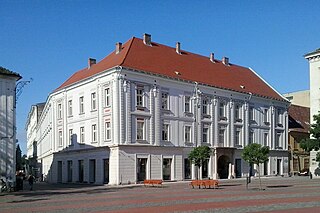
Timișoara is the capital city of Timiș County and the main economic, social and cultural center in western Romania. Located on the Bega River, Timișoara is considered the informal capital city of the historical Banat. From 1848 to 1860 it was the capital of the Serbian Vojvodina and the Voivodeship of Serbia and Banat of Temeschwar.

The national flag of Romania is a tricolor with vertical stripes, beginning from the flagpole: blue, yellow and red. It has a width-length ratio of 2:3.
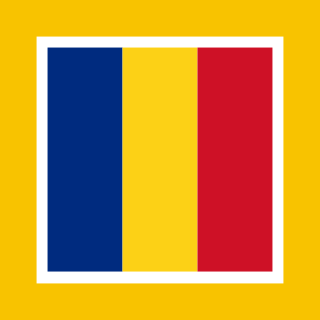
The prime minister of the Government of Romania is the head of the Government of Romania. Initially, the office was styled President of the Council of Ministers, when the term "Government" included more than the Cabinet, and the Cabinet was called The Council of Ministers. The title was officially changed to Prime Minister by the 1965 Constitution of Romania during the communist regime.

In heraldry, the field (background) of a shield can be divided into more than one area, or subdivision, of different tinctures, usually following the lines of one of the ordinaries and carrying its name. Shields may be divided this way for differencing or for purposes of marshalling, or simply for style. The lines that divide a shield may not always be straight, and there is a system of terminology for describing patterned lines, which is also shared with the heraldic ordinaries. French heraldry takes a different approach in many cases from the one described in this article.

The coat of arms of Toronto, Ontario, Canada, was designed by Robert Watt, the Chief Herald of Canada at the time, for the City of Toronto after its amalgamation in 1998. The arms were granted by the Canadian Heraldic Authority on 11 January 1999.

Zalău is the seat of Sălaj County, Romania. In 2011, its estimated population was 56,202.

The Dacian Draco was the standard ensign of troops of the ancient Dacian people, which can be seen in the hands of the soldiers of Decebalus in several scenes depicted on Trajan's Column in Rome, Italy. It has the form of a dragon with open wolf-like jaws containing several metal tongues. The hollow dragon's head was mounted on a pole with a fabric tube affixed at the rear. In use, the draco was held up into the wind, or above the head of a horseman, where it filled with air and gave the impression it was alive while making a shrill sound as the wind passed through its strips of material.

Zsolt Nagy is a Romanian politician of Hungarian ethnicity.

The coat of arms of Bucharest is the heraldic symbol of the capital city of Romania. The present-day coat of arms was adopted by Domnitor Alexandru Ioan Cuza, and changed under the Communist regime. In 1994, it was renewed again with minor alterations.

The coat of arms and flag of Transylvania were granted by Maria Theresa in 1765, when she established a Grand Principality within the Habsburg Monarchy. While neither symbol has official status in present-day Romania, the coat of arms is marshalled within the national Romanian arms; it was also for decades a component of the Hungarian arms. In its upper half, it prominently includes the eagle, which may have been one of the oldest regional symbols, or is otherwise a localized version of the Polish eagle. Early versions of the Transylvanian charges were first designed in Habsburg Hungary at some point before 1550, and were therefore symbols of pretence.

The Romanian government is the armiger in Romania. It exercises this right under the mandatory advice of the National Committee of Heraldry, Genealogy and Sigillography. The committee is subordinate to the Romanian Academy. All the coats of arms of Romanian institutions must be approved by this committee with two exceptions. The Romanian military is subject to the Ministry of National Defense Heraldric Committee, and Romanian law enforcement institutions are subject to the Ministry of Administration and Interior Heraldric Committee. Both of these committees may share members with the National Committee of Heraldry, Genealogy and Sigillography.

The colors of the national flag of Romania have a long history, though the association of the three colors only dates to the 18th century. Red, yellow and blue were found on late 16th-century royal grants of Michael the Brave, as well as shields and banners. Thus, the late 13th century Wijbergen armorial shows the coat of arms of the Wallachian ruler Litovoi as consisting of a shield of ten vertically alternating gold-and-red bands, which were the colors of the coat of arms of the Second Bulgarian Empire, of which Wallachia was part. The same two colors, gules and or, also appeared on the late 15th century flag and coat of arms of Moldavia, during the reign of Stephen the Great. Then, from the late 16th century until the mid-17th century, the historical coat of arms of Transylvania gradually developed as a shield party per fess, consisting of a black eagle on blue background in the upper field, a dividing red band in the middle, and seven red towers on golden background in the lower field. Finally, in the last quarter of the 18th century, Bukovina gets its own coat of arms from the Habsburg Empire, a blue-and-red shield party per pale with a black aurochs' head in the middle, and three golden six-pointed stars surrounding it. During the Wallachian uprising of 1821, they were present, along others, on the canvas of the revolutionaries' flag and its fringes; for the first time a meaning was attributed to them: "Liberty (sky-blue), Justice, Fraternity ".

The coat of arms of Colchester is the arms and other insignia associated with the town of Colchester, England.
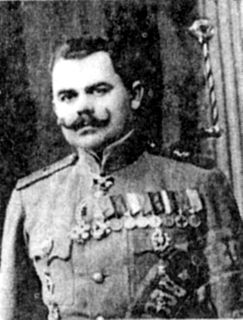
Paul Gore was a Bessarabian politician and historian, he wrote prose and publicist materials, he was the honorary member (1919) of the Romanian Academy, he was the president of the National Moldavian Party. "Very cultured man, he owned a vast library and he knew the history of Bessarabia in detail" .

Clubul Sportiv Municipal București, also known as CSM București, CSM or CSM Bucharest, is a women's handball team based in Bucharest, Romania, that competes in the Liga Naţională and the EHF Champions League.

Major Nicolae Dabija, knight of Order of Michael the Brave, was an officer of the Romanian Royal Army and a member of the anticommunist armed resistance in Romania. He was the leader of the "National Defense Front–The Haiduc Corps" resistance group.
Romania participated in the Eurovision Song Contest 2018 with the song "Goodbye", written by Alexandru Matei, Alin Neagoe and Cristina Caramarcu, and performed by The Humans. The song was selected through a national final organized by the Romanian broadcaster Televiziunea Română (TVR).
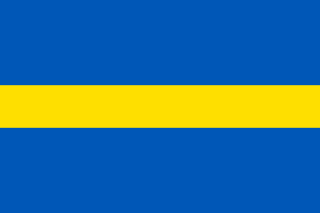
The flag of Cimișlia is the official flag of the city of Cimișlia, in the Cimișlia District, Moldova. It is a simple horizontal tricolor, composed of blue stripes at the top and bottom and a yellow one in the middle. Blue represents the sky and other values and elements, while yellow signifies the richness of Cimișlia's cereals, very important in the history of the city. Previous proposals included the inclusion in the canton (corner) of the coat of arms of the city or a Tatar symbol called danga in Romanian.
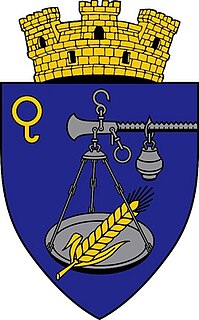
The coat of arms of Cimișlia is the official coat of arms of the city of Cimișlia, in the Cimișlia District, Moldova. It consists of a silver balance coming out of the coat of arms on the left and that holds an ear of grain representing the wealth of the city's cereals. On the canton (corner) of the coat of arms is the danga of a Tatar tribe, a unique symbol of Cimișlia. The field is blue, representing the sky and other values and elements. Above the coat of arms is a mural crown with three towers. It was proposed to use the coat of arms on the flag of Cimișlia, which was approved for a few months before the flag was changed again to its current form.






















